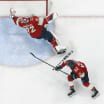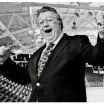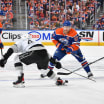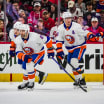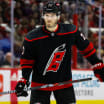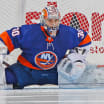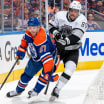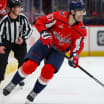Classic NHL games have become prevalent since the NHL season paused March 12 due to concerns surrounding the coronavirus. The games have been fun to watch, but they are also instructional. Unmasked focuses on the goalies from previous years, explaining how changes in equipment altered playing style.
This week, Unmasked looks specifically at the evolution of chest protectors. Next week, the changes in leg pads will be examined.
Advances in chest protectors give goalies confidence to make body saves
Catching pucks was preferred when fear factor was higher with less padding
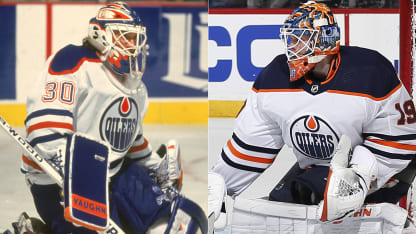
By
Kevin Woodley
NHL.com Independent Correspondent
If there's one thing that jumps out while watching the classic NHL games airing across multiple platforms while the NHL season is paused, it's how different the goalies look.
St. Louis Blues defenseman Alex Pietrangelo mentioned it this week in a casual conversation during a video call organized by the NHL, remarking to Chicago Blackhawks forward Patrick Kane about the difference in the appearance of goalies in those classic games.
The size difference in goalies and the more form-fitting pads they wear are striking. But there is also a lot of extra movement from goalies, and reaching for the puck is much more prevalent than the quieter style used by current-era goalies. Limbs are flying everywhere. By the puck-stopping standards of today, the word "flailing" comes to mind.
Columbus Blue Jackets goaltending coach
Manny Legace
remembers watching that generation of goalies when he was growing up and having a lot of similar questions about style.
"I was that guy that would sit there and watch the stand-up goalies] and [New York Islanders forward] Mike Bossy coming down the wall and firing it on the ice and they're standing up and I'm like, 'Why aren't you guys going down?'" said Legace, who played 365 NHL games in 11 seasons from 1998-2010. "But I didn't realize the fear factor those goalies had.
"The mentality of the shooter was waste one by [a goalie's] head and then throw the next one by their feet, and I didn't realize the whole thought process in that as I was watching it as a kid. My guys didn't shoot that hard."
***[RELATED: [Goalies receiving financial, mental health support from Goalie Guild]*
Watching classic games and wondering how goalies got from there to where we are today, the most obvious answer is the position-specific instruction that predates similar evolutions for forwards and defensemen. While most shooters spent each offseason focused on getting bigger, stronger and faster, goalies spent time with coaches working to improve technique.
But even that coaching evolution is predated by a key change to their equipment, specifically chest protectors. It wasn't just that the chest pads became bigger -- and made goalies look bigger -- but more importantly, it reduced and eventually eliminated the fear factor Legace mentioned.
The shift stared in the mid-1980s with the introduction of integrated chest-and-arm protectors that began incorporating more plastic pieces and small blocks of foam. Previously, goalies wore separate pieces of protection on their chest and arms, primarily made of felt.
"It wasn't that protective," said
Sean Burke
, who played 820 NHL games in 18 seasons from 1987-2007. "Coming out of junior in 1986] was probably the last time I wore a two-piece upper-body [pad] where your arm protection and chest protection were two different pieces and you didn't have elbow caps or shoulder caps. Everything was protected, but not to the degree that if you took a shot you weren't going to feel it.
"So you just caught more pucks. You didn't block. You didn't go down into a butterfly position until you had to. It really has changed the way the position has been played because there's not the same fear anymore, for sure."
Burke, who was a goaltending coach for the Arizona Coyotes from 2009-15 and now works as a pro scout for the Montreal Canadiens, was careful to point out that the equipment needed to change as stick technology evolved and the speed of shots increased.
With the improvements, Burke said it no longer hurt as much to take a shot off the arm or body, and the need to reach and catch the puck to avoid the pain associated with blocking high shots was eliminated, allowing goalies to think about new ways to make saves.
Not all goalies see limited protection as the biggest reason for the old style.
"I think we just learned to have active hands; most of us played baseball," said
[Bill Ranford
, who played 647 NHL games in 15 seasons from 1985-2000 and has been the Los Angeles Kings goaltending coach since 2006. "Not getting hit was never a thought for me. We talk about it now because the arm pads are so much more protective. The old what-if scenario: 'What if I had this better protection?'"
As Ranford, Burke and Legace each said, it still hurt to get hit in certain parts of those early integrated chest protectors, especially when struck on the arm, or around the elbow or collarbone.
As protection increased, it became easier to teach a style rooted in finding ways to move more powerfully and efficiently into position, whether on skates or knees, to be square to a shooter and take a shot off the chest.
Active hands still matter, even more so in recent years, but they are no longer a safety measure, but an additional skill.
Current goalies are comfortable being encouraged to shift their torso into harder shots, something that was unimaginable three decades ago.
"There was a lot of fear to playing goalie back then," Legace said. "The game changed, and equipment got better, and the fear was gone, and guys started going down and then it's just developed and developed and developed. And right now, there's really no fear in being a goalie, and that's why the [scoring] numbers are down and why we look at 6-5 games and 7-6 games back in the '80s, where now it's 2-1 and 3-2 because of the goalies."
